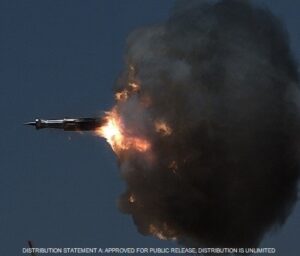BAE Systems and a team of Boeing [BA] and Norway’s
Nammo achieved record ranges in recent tests with their new long-range artillery projectiles, the companies said Monday, as the firms eye a potential Army program to pursue such capabilities.
Jim Miller, BAE Systems’ vice president of business development, told reporters on Monday he believes the company’s XM1155-SC guided projectile has been fired out farther than Boeing and Nammo’s ramjet-powered 155 projectile in testing to date, while the companies declined to disclose specific distances.

“We believe we’ve beaten them several times over. And we believe we’ve done it guided and they have not,” Miller told reporters during a briefing at the Association of the United States Army’s annual conference in Washington, D.C. “We believe we’re winning the race. We do know they did not shoot guided. We’re not sure about the ranges.”
BAE Systems said its most recent test of the XM1155-SC projectile, in partnership with the Army’s Combat Capabilities Development Command Armaments Center, was “the furthest distance an M109 Paladin has ever fired a guided projectile.”
“We’re just getting started showing the advanced capabilities that this round brings to the warfighter. This projectile delivers a leap forward in performance and modernization. This successful firing and previous test results show that our concept is on-track to provide range and lethality overmatch to the U.S. Army brigade and division artillery units,” Brent Butcher, BAE Systems’ vice president and general manager of weapon systems, said in a statement.
Jim Leary, Boeing’s senior director of business development for space, intelligence and weapon systems, told Defense Daily on Monday the recent live fire test of its Ramjet 155 solution from the Army’s 58-caliber Extended Range Cannon Artillery (ERCA) prototype set a record distance that exceeded the range from a previous test by more than a third.
“And that live fire range was even limited by the physical capacity of the [test] range. So it could have gone farther if we’d have had more space,” Leary said.
Boeing said on Monday it will integrate a precision guidance system, a Joint Direct Attack Munition (JDAM), in an upcoming test with its Ramjet 155 solution.
“The demonstration will evaluate the system’s maturity and effectiveness against stationary and moving targets, and readiness to transition into the next phase of development,” Boeing said in a statement on Monday.
Both companies are developing their projectile solutions under the Army’s XM1155 program to inform requirements for long-range munitions that could be fired by the ERCA artillery system.
Boeing and Nammo announced last August they had successfully fired their Ramjet 155 weapon during a test in Norway, which followed years of research and development work, to include more than 450 static or short-range tests (Defense Daily, Aug. 11 2022).
“The ranges are great. What’s even better is a ramjet [capability] out of a cannon without ruining the cannon,” Leary said. “It’s the sort of lifecycle savings on the breach and the cannon that a ramjet brings [compared] to just tube artillery that makes a huge difference. It’s about that coupled with the [extended] ranges.”
BAE Systems held the first test fire of its XM1155-SC projectile with the Army last December from an ERCA test bed, which the company has said showcased the ability to “defeat long-range targets and advance to follow-on testing out to double the range of existing guided projectiles and with sensors to find fixed and moving targets of interest.”
“Our intent with that round now is to prove that we can double the range of traditional artillery regardless of the caliber of the gun and we can hit imprecisely-located or moving targets in a contested environment. So that’s what we’re out to prove,” Miller told reporters on Monday.
Both BAE Systems and Boeing noted the Army is currently working through an artillery study which is likely to inform the service’s potential pathway on pursuing such long-range projectiles.
“There is clear opportunity and interest to move it to a program of record. We’re excited about that and we’re happy we’re in lockstep with the Army on this one,” Leary said.